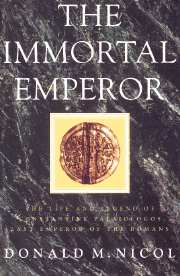Book contents
4 - THE FALL OF CONSTANTINOPLE
Published online by Cambridge University Press: 28 October 2009
Summary
As soon as he got back to Adrianople the Sultan began to plan the construction of a fortress on the European shore of the Bosporos. Thirty-five years earlier his grandfather Bayezid had built a castle on the Adriatic shore of the straits. It came to be called Anadolu Hisar. Mehmed proposed to build its pair on the opposite side, thereby controlling the sea traffic up and down the Bosporos and blockading Constantinople by land and sea. In the winter of 1451 he ordered skilled masons and labourers to be gathered from all his provinces and building material to be transported to the site which he had selected, at the narrowest part of the channel. The people of Constantinople feared the worst. They sensed that all the prophecies about the end of their world and the coming of the Antichrist were about to come true. In the spring of 1452 they could see that work on the fortress had begun. All that the Emperor could do was protest. He sent messengers to the Sultan to remind him of their treaty. He pointed out that Mehmed's grandfather had respectfully sought permission from the Emperor Manuel II before building his castle on the Asiatic side of the straits, which was in any case on Ottoman territory. Mehmed was not inclined to explain what he was about nor to be conciliatory. Clearly both sides of the Bosporos were in Ottoman control. His grandfather had had it in mind to build a fortress on the European shore. He did not live to achieve it. What the Sultan did or proposed to do was none of the Emperor's business.
- Type
- Chapter
- Information
- The Immortal EmperorThe Life and Legend of Constantine Palaiologos, Last Emperor of the Romans, pp. 54 - 73Publisher: Cambridge University PressPrint publication year: 1992



